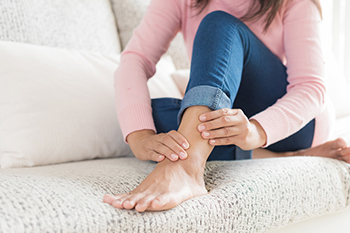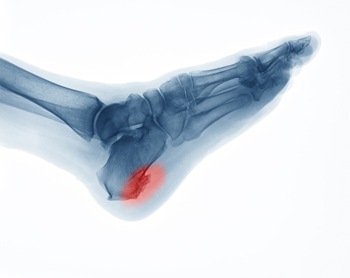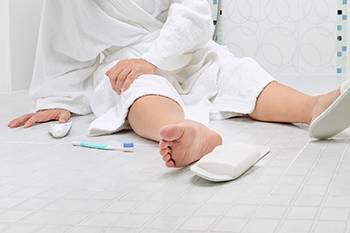Items filtered by date: February 2022
Reminder: When Was the Last Time...?
Heel Spurs: The Body’s Response to Stress on Ligaments and Tendons
A heel spur is a pointy accumulation of calcium deposits that build up over time on the heel bone. They are the body’s response to repetitive strain or localized inflammation where soft tissues meet the bone. Heel spurs can develop at various locations on the heel bone. When the Achilles tendon becomes inflamed, a heel spur can sometimes develop at the back of the heel (where the tendon attaches to the bone). When the long tissue that connects the toes with the heel (plantar fascia) becomes damaged and inflamed, heel spurs can sometimes form on the heel under the arch. Obesity, gait abnormalities, flat feet or high arches, age, improperly fitted shoes, and other factors that stress the feet can also contribute to the formation of a heel spur. Some heel spurs can cause pain and tenderness, while others are asymptomatic, and only become discovered on an X-ray taken to diagnose another condition. A podiatrist can treat a heel spur through a variety of conservative treatments including icing and resting, physical therapy, stretching, oral or injectable anti-inflammatory medications, and custom orthotic devices.
Heel spurs can be incredibly painful and sometimes may make you unable to participate in physical activities. To get medical care for your heel spurs, contact one of our podiatrists from Sayville Foot Care. Our doctors will do everything possible to treat your condition.
Heels Spurs
Heel spurs are formed by calcium deposits on the back of the foot where the heel is. This can also be caused by small fragments of bone breaking off one section of the foot, attaching onto the back of the foot. Heel spurs can also be bone growth on the back of the foot and may grow in the direction of the arch of the foot.
Older individuals usually suffer from heel spurs and pain sometimes intensifies with age. One of the main condition's spurs are related to is plantar fasciitis.
Pain
The pain associated with spurs is often because of weight placed on the feet. When someone is walking, their entire weight is concentrated on the feet. Bone spurs then have the tendency to affect other bones and tissues around the foot. As the pain continues, the feet will become tender and sensitive over time.
Treatments
There are many ways to treat heel spurs. If one is suffering from heel spurs in conjunction with pain, there are several methods for healing. Medication, surgery, and herbal care are some options.
If you have any questions feel free to contact our office located in Sayville, NY . We offer the latest in diagnostic and treatment technology to meet your needs.
When an Ankle Sprain Can Also Be a Fracture
 If your ankle suddenly rolls inward, causing great pain and swelling, you may have more than a sprain. If the outer ligament is torn during an injury, it sometimes lops off a small piece of bone at the end of the fibula (the outer leg bone). Though this injury is known as a fibular avulsion fracture, it is often thought of as a moderate-to-severe ankle sprain and will not likely need surgery. Rest, ice, elevation and anti-inflammatory medication can help ease the pain. The ability to bear weight is extremely limited, and a boot or brace may also be needed to immobilize the foot. The injury is most common in older women because of osteoporosis that weakens the bones and young men whose ligaments may be much stronger than their bones. If you experience such an injury, it is suggested that you see a podiatrist as soon as possible for X-rays, diagnosis and treatment options.
If your ankle suddenly rolls inward, causing great pain and swelling, you may have more than a sprain. If the outer ligament is torn during an injury, it sometimes lops off a small piece of bone at the end of the fibula (the outer leg bone). Though this injury is known as a fibular avulsion fracture, it is often thought of as a moderate-to-severe ankle sprain and will not likely need surgery. Rest, ice, elevation and anti-inflammatory medication can help ease the pain. The ability to bear weight is extremely limited, and a boot or brace may also be needed to immobilize the foot. The injury is most common in older women because of osteoporosis that weakens the bones and young men whose ligaments may be much stronger than their bones. If you experience such an injury, it is suggested that you see a podiatrist as soon as possible for X-rays, diagnosis and treatment options.
Foot and ankle trauma is common among athletes and the elderly. If you have concerns that you may have experienced trauma to the foot and ankle, consult with one of our podiatrists from Sayville Foot Care. Our doctors will assess your condition and provide you with quality foot and ankle treatment.
Foot and ankle trauma cover a range of injuries all over the foot; common injuries include:
- Broken bones
- Muscle strains
- Injuries to the tendons and ligaments
- Stress fractures
Symptoms
Symptoms of foot and ankle injuries vary depending on the injury, but more common ones include:
- Bruising
- Inflammation/ Swelling
- Pain
Diagnosis
To properly diagnose the exact type of injury, podiatrists will conduct a number of different tests. Some of these include sensation and visual tests, X-rays, and MRIs. Medical and family histories will also be taken into account.
Treatment
Once the injury has been diagnosed, the podiatrist can than offer the best treatment options for you. In less severe cases, rest and keeping pressure off the foot may be all that’s necessary. Orthotics, such as a specially made shoes, or immobilization devices, like splints or casts, may be deemed necessary. Finally, if the injury is severe enough, surgery may be necessary.
If you have any questions, please feel free to contact our office located in Sayville, NY . We offer the newest diagnostic and treatment technologies for all your foot care needs.
Helping Your Aging Loved One Avoid Falling
Falling for an older adult can be very dangerous both physically and emotionally. According to the National Council on Aging, falls are the primary cause of injury for adults aged 65 and older. What’s more, feelings of depression and apprehension after a fall can prevent them from staying active as well. Here are some basic steps you can take to help the aging adult in your life avoid falling and tripping. Remove any clutter from walkways and stairs and make sure there is ample lighting in these areas. All staircases should have rails on both sides. Remove or secure any loose rugs or mats. In the bathroom, install grab bars in the shower and near the commode. Have their eyes examined to make sure their prescription is current. Check to make sure they aren’t taking any medications that make them drowsy or dizzy. If you see them struggling to get up out of chairs or if they are holding onto walls or furniture to walk around, schedule an appointment with a podiatrist. The podiatrist can assess and treat any existing foot conditions and analyze and correct their gait and balance issues with custom orthotics and shoe modifications. They can also suggest specific exercises and stretches to maintain optimal foot and ankle health.
Preventing falls among the elderly is very important. If you are older and have fallen or fear that you are prone to falling, consult with one of our podiatrists from Sayville Foot Care. Our doctors will assess your condition and provide you with quality advice and care.
Every 11 seconds, an elderly American is being treated in an emergency room for a fall related injury. Falls are the leading cause of head and hip injuries for those 65 and older. Due to decreases in strength, balance, senses, and lack of awareness, elderly persons are very susceptible to falling. Thankfully, there are a number of things older persons can do to prevent falls.
How to Prevent Falls
Some effective methods that older persons can do to prevent falls include:
- Enrolling in strength and balance exercise program to increase balance and strength
- Periodically having your sight and hearing checked
- Discuss any medications you have with a doctor to see if it increases the risk of falling
- Clearing the house of falling hazards and installing devices like grab bars and railings
- Utilizing a walker or cane
- Wearing shoes that provide good support and cushioning
- Talking to family members about falling and increasing awareness
Falling can be a traumatic and embarrassing experience for elderly persons; this can make them less willing to leave the house, and less willing to talk to someone about their fears of falling. Doing such things, however, will increase the likelihood of tripping or losing one’s balance. Knowing the causes of falling and how to prevent them is the best way to mitigate the risk of serious injury.
If you have any questions, please feel free to contact our office located in Sayville, NY . We offer the newest diagnostic and treatment technologies for all your foot care needs.
Ways Runners Can Help Prevent Injuries
Runners often sustain foot injuries that can range from stress fractures to sprained ankles. However, there are many ways to help prevent them. The best method to implement is to warm up and stretch the feet and legs before running and to include a regular cool-down routine afterward. Second, start at a modest pace and add time and distance gradually, so your feet and the rest of your body can accommodate the changes. Third, be sure to wear shoes that are specifically designed for running, as this can help to avoid heel, ankle, and toe injuries. If you sustain such an injury while running, it’s a good idea to stop the activity until you can determine the cause and severity. Pushing through the pain can make it worse. Wrap your foot and ice it. Keep it elevated. It is a good idea to make an appointment with a podiatrist as quickly as possible for a diagnosis and appropriate treatment plan.
All runners should take extra precaution when trying to avoid injury. If you have any concerns about your feet, contact one of our podiatrists of Sayville Foot Care. Our doctors will treat your foot and ankle needs.
How to Prevent Running Injuries
There are a lot of mistakes a runner can make prior to a workout that can induce injury. A lot of athletes tend to overstretch before running, instead of saving those workouts for a post-run routine. Deep lunges and hand-to-toe hamstring pulls should be performed after a workout instead of during a warmup. Another common mistake is jumping into an intense routine before your body is physically prepared for it. You should try to ease your way into long-distance running instead of forcing yourself to rush into it.
More Tips for Preventing Injury
- Incorporate Strength Training into Workouts - This will help improve the body’s overall athleticism
- Improve and Maintain Your Flexibility – Stretching everyday will help improve overall performance
- “Warm Up” Before Running and “Cool Down” Afterward – A warm up of 5-10 minutes helps get rid of lactic acid in the muscles and prevents delayed muscle soreness
- Cross-Training is Crucial
- Wear Proper Running Shoes
- Have a Formal Gait Analysis – Poor biomechanics can easily cause injury
If you have any questions, please feel free to contact our office located in Sayville, NY . We offer the newest diagnostic and treatment technologies for all your foot care needs.




